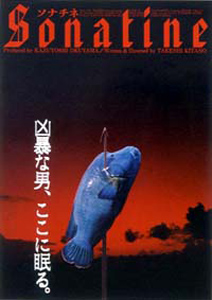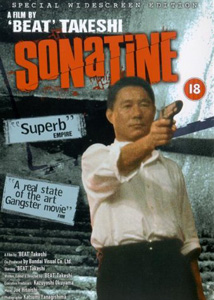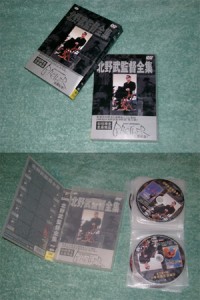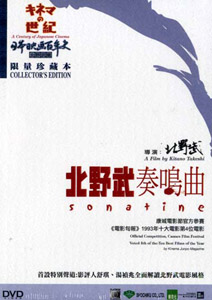![]()

![]()
(aka "Sonachine" )
directed
by Kitano Takeshi
Japan 1993
With “Sonatine”, Kitano hit the international scene. Already
world famous, at least five times over in Japan, the rest of the world knew next
to nothing about him. Here came a film, so fresh and inventive, that some
already began talking about a possible new master.
"Sonatine" opens with a shock, precisely 1 minute 27 seconds into the film. A 38
second shot begins, as a static Close Up of a boy sorting mah-jong pieces,
suddenly, after 14 seconds, the camera pulls back in a tracking shot for 11
seconds, allowing Kitano and Terajima to enter and leave the frame, leaving us
with a 13 second static Medium Long Shot of the boy, still sorting pieces.
Considering Kitano's persistent use of static frame compositions in his previous
three films, this 38 second shot, especially the 11 seconds of backward
tracking, hits one in the face, as if a mute person suddenly utters a word.
It is also the first film where composer Jo Hisaishi’s minimalist score really
carries the images. It is the first of many things, all showing a mature and
confident Kitano; Thus, “Sonatine” is rightfully the first real Kitano film.
Kitano himself agrees upon this, when he says: “...it is with Sonatine that I
had the feeling to achieved the first stage as a director."
Aniki (Kitano) is an underboss in the Yakuza. Becoming increasingly bored with
the daily routines and having run out of steam, he considers retirement. When
another yakuza underboss, who is envious of his success, plots and causes Aniki
to lose his territory and family, and forcing him to hide, he sees it as an
opportunity to start fresh. But can he?
The title derives from a musical term meaning little sonata, which amongst other
is used for simple educational pieces; Kitano elaborates: “When learning to play
the piano, one studies various types of pieces. When one acquires the basic
knowledge of these pieces, one has reached sonatine. Its not really control, but
it marks the end of first stage of training.”
Henrik Sylow of kitanotakeshi.com
Posters
 |
Theatrical Release: June 5, 1993
Reviews More Reviews DVD Reviews
DVD Comparison:
MIA - Region 2 - PAL vs. Chinese Bootleg - Region 3 - NTSC vs. Panorama - Region 3 - NTSC
Big thanks to for all the Screen Caps!
(MIA - Region 2 - PAL - LEFT vs. Chinese Bootleg - Region 3 - NTSC - MIDDLE vs. Panorama - Region 3 - NTSC - RIGHT)
| DVD Box Covers |
|
|
|
| Distribution |
MIA Region 2 - PAL |
Chinese
Bootleg Region 3 - NTSC |
Panorama Region 3 - NTSC |
| Runtime | 1:33:55 | 1:33:50 | 1:34:05 |
| Video |
1.82
Aspect Ratio |
1.78 Aspect Ratio
16X9 enhanced |
1.80
Aspect Ratio |
|
Bitrate:
MIA NOTE: The Vertical axis represents the bits transferred per second. The Horizontal is the time in minutes. |
|
||
|
Bitrate:
Chinese Bootleg
|
|
||
|
Bitrate:
Panorama
|
|
||
| Audio | 2.0 Dolby Digital Japanese |
2.0 Dolby Digital Japanese |
2.0 Dolby Digital Japanese, 5.1 Dolby Digital Japanese |
| Subtitles | English, None | None | Chinese, English, None |
| Features |
Release Information: Studio: MIA Aspect Ratio:
Edition Details:
Chapters
12 |
Release Information: Studio: Chinese Bootleg Aspect Ratio:
Edition Details:
DVD
Release Date: Chapters 10 |
Release Information: Studio: Panorama Aspect Ratio:
Edition Details:
DVD
Release Date: September 12, 2002 Chapters 12 |
| Comments |
The Chinese Bootleg is from the
Bandai DVD and, once more, is the best of the compared. The MIA DVD looks
basically as a direct transfer from the Panorama, only with different
subtitles, as both colour scheme and bottom / left cropping of 2,5% are the
same. The Chinese Bootleg has a sharper more detailed picture and the colours are rich and saturated. It simply is a delight to watch. Regarding the sound, the Panorama has a 5.1 DD track, which adds some space to especially the music of Hisaishi. While it is nice, the film loses nothing from the 2.0 DD track. If one should chose between the Panorama and the MIA, I would suggest the MIA, simply because the subtitling is better. Announced August 2003 and to be released in January 2004, the long awaited Miramax US R1 version of “Sonatine” was pulled indefinitely and is currently not on their release schedule. As it was to be released thru Buena Vista Home Entertainment, the current problems between Disney and Miramax is not the most fertile in regards to it returning. Thus the sad fact is, that there are no 16x9 editions of “Sonatine” with English subtitles available, unless one gets hold of the rare OOP Kitano box (Kitano Takeshi Kantoku Zenshu). |
||
DVD Menus
(MIA - Region 2 - PAL - LEFT vs.
Chinese Bootleg - Region 3 - NTSC - MIDDLE vs. Panorama - Region 3 - NTSC
- RIGHT)
|
|
|
|
|
|
|
|
|
|
|
|
|
|
||
|
|
Subtitle Samples
(MIA - Region 2 - PAL - TOP vs. Panorama - Region 3 - NTSC - BOTTOM)
|
|
|
|
Screen Captures
(MIA - Region 2 - PAL - TOP vs. Chinese Bootleg - Region 3 - NTSC - MIDDLE vs. Panorama - Region 3 - NTSC - BOTTOM)
|
|
|
|
|
|
(MIA - Region 2 - PAL - TOP vs. Chinese Bootleg - Region 3 - NTSC - MIDDLE vs. Panorama - Region 3 - NTSC - BOTTOM)
|
|
|
|
|
|
(MIA - Region 2 - PAL - TOP vs. Chinese Bootleg - Region 3 - NTSC - MIDDLE vs. Panorama - Region 3 - NTSC - BOTTOM)
|
|
|
|
|
|
(MIA - Region 2 - PAL - TOP vs. Chinese Bootleg - Region 3 - NTSC - MIDDLE vs. Panorama - Region 3 - NTSC - BOTTOM)
|
|
|
|
|
|
(MIA - Region 2 - PAL - TOP vs. Chinese Bootleg - Region 3 - NTSC - MIDDLE vs. Panorama - Region 3 - NTSC - BOTTOM)
|
|
|
|
|
|
(MIA - Region 2 - PAL - TOP vs. Chinese Bootleg - Region 3 - NTSC - MIDDLE vs. Panorama - Region 3 - NTSC - BOTTOM)
|
|
|
|
|
|
Report Card:
|
Image: |
Chinese Bootleg |
|
Sound: |
Panorama |
| Extras: | Panorama |
| Menu: | Panorama |




